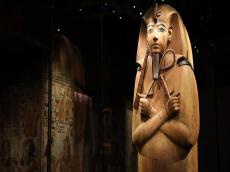|
|
TODAY.AZ / World news
Archaeologists solve mystery of sarcophagus of Ramses II
04 June 2024 [22:23] - TODAY.AZ

By Alimat Aliyeva
Archaeologists have established that a fragment of a sarcophagus hidden under the floor of a Coptic building once belonged to the sarcophagus of Ramses II. The mystery of the famous Pharaoh's sarcophagus, which has not been solved so far, has finally been solved. A fragment of granite was discovered inside a Coptic building in Abydos, an ancient city in east-central Egypt, Azernews reports.
Egyptian archaeologist Ayman Damrani discovered it in 2009. With the help of their American colleague Kevin Kahail, in 2017 they published the results of a study of the texts and design of the fragment. The team of specialists found that two people were in the sarcophagus at different times. However, they were only able to identify the last one, Menheperre, the "high priest of the 21st dynasty" who lived around 1000 BC, according to a statement from France's National Center for Scientific Research. The original owner of the sarcophagus, a container covered with carvings and texts, remained a mystery. But archaeologists knew that it belonged to "a very high-ranking figure of the New Egyptian Kingdom," the statement said.
As Egyptologist Frederic Peyrodeau of Orient et Méditerranée 1, who officially identified the fragment, explains, the Valley of the Kings was repeatedly plundered during the reign of the 19th dynasty of Ancient Egypt, during an era of economic and social crises that led to shortages, forcing even members of the royal family to reuse burial objects created for their predecessors.
Further investigation of a fragment of engraved and decorated granite with a length of 1.70 meters and a thickness of 8 centimeters allowed a teacher and researcher from the Sorbonne University in France to associate Ramses II with the sarcophagus. To do this, he deciphered a forgotten cartouche, an oval-shaped engraving depicting the name of the Pharaoh, "Ramses II himself." The scientist published his findings in the journal Revue D'egyptologi.
Ramses II was the third ruler of the 19th dynasty of Ancient Egypt and ruled from 1279 to 1213 BC. He is known for the expansion of the Egyptian empire to the territory of modern Syria, as well as for his construction projects, including the expansion of the Karnak Temple. The Pharaoh was buried in a gilded wooden coffin, which was placed inside an alabaster sarcophagus and a larger granite sarcophagus.
According to the Egyptian Museum, in 1881, the mummy and coffin of Ramses were discovered in a cache in the Deir el-Bahari temple complex, where the remains of 50 other members of the nobility, including the father of Pharaoh Seti I, were kept. Since then, the golden coffin and the mummy of Ramses have been exhibited in museums around the world. It remains unclear whether the fragment of the sarcophagus, which is currently stored in Abydos, will ever be put on public display.
URL: http://www.today.az/news/regions/249197.html
 Print version
Print version
Connect with us. Get latest news and updates.
See Also
- 23 December 2024 [23:30]
South Korean team develop an Iron Man robot - 23 December 2024 [22:20]
New Zealand rejects plan to introduce its own passports for residents of Cook Islands - 23 December 2024 [21:22]
Philippines plans to purchase Typhon missile launchers from United States - 23 December 2024 [14:58]
Japarov urges European Parliament to respect Kyrgyzstan's sovereignty - 23 December 2024 [13:05]
Macron described as 'extremely paranoid', says French media - 23 December 2024 [09:00]
Georgian PM warns Zourabichvili over election proposal - 23 December 2024 [08:00]
Israeli delegation explores ceasefire deal in Doha talks - 22 December 2024 [23:30]
Biden signs government funding bill, averts shutdown - 22 December 2024 [23:00]
German police probe market attack security and warnings - 22 December 2024 [21:30]
Putin: No need to scare anyone with third world war talk
Most Popular
 IDPs return to rebuilt Shusha as part of Great Return State Program
IDPs return to rebuilt Shusha as part of Great Return State Program
 Pashinyan plants a pig for the Armenians
Pashinyan plants a pig for the Armenians
 Azerbaijan, Russia inks agreement on Development of Transit Freight Transportation
Azerbaijan, Russia inks agreement on Development of Transit Freight Transportation
 Sweden's Climate and Environment Minister calls for Shein and Temu to be banned in country
Sweden's Climate and Environment Minister calls for Shein and Temu to be banned in country
 President Ilham Aliyev's remarks in his interview with Dmitry Kiselev in spotlight of world media
President Ilham Aliyev's remarks in his interview with Dmitry Kiselev in spotlight of world media
 Changing global geopolitics & implications for Pakistan
Changing global geopolitics & implications for Pakistan
 S. Korea to launch 3rd homegrown military spy satellite
S. Korea to launch 3rd homegrown military spy satellite
